Amides can be reduced to amines by LiAlH4:

Remember that the reduction of all the other carboxylic acid derivatives containing a carbonyl group produces alcohols:
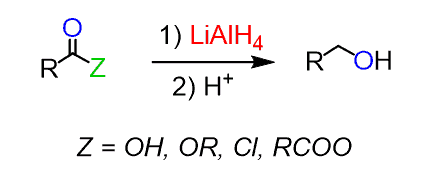
Another exception is the nitriles, but these do not contain a carbonyl group, and depending on the reducing agent, different products can be obtained.
The reduction of amides differs in one important parameter, and that is, unlike the other derivatives, they lose the carbonyl oxygen during the reaction. Let’s compare the reduction of esters and amides to illustrate this feature:
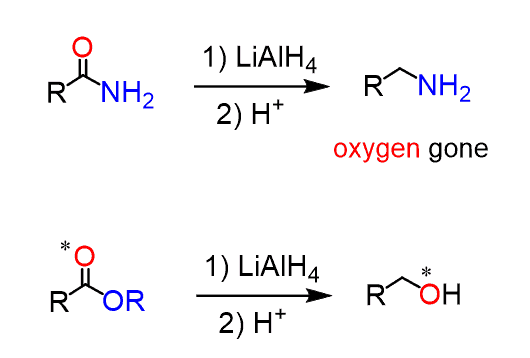
The leaving group in ester reduction is the RO–, alkoxy group, while for amides, the carbonyl oxygen is converted into a leaving group and then eliminated.
The Mechanism of Amide Reduction by LiAlH4
Primary and secondary amides have a proton connected to the nitrogen that is acidic enough to be attacked by the hydride. This step occurs before the nucleophilic addition of the hydride ion:
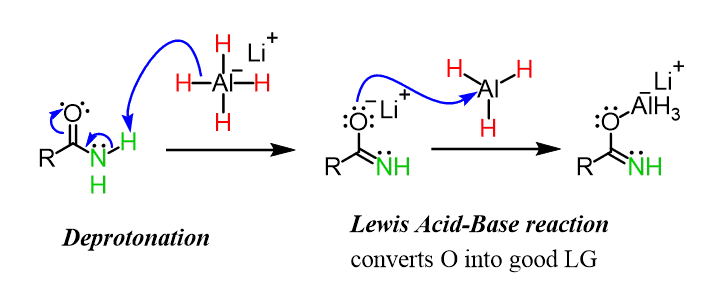
After the reaction with AlH3, the C=O oxygen is converted into a good leaving group and eliminated in the addition-elimination step:
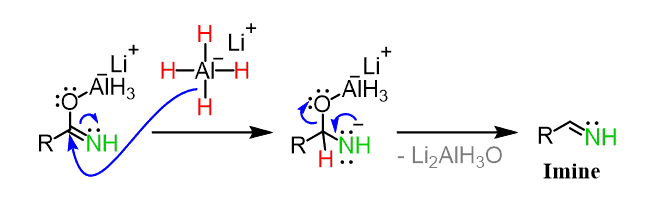
The C=N bond of the imine is then reduced just like any carbonyl group. In the last, either water aqueous solution is used as a work-up.
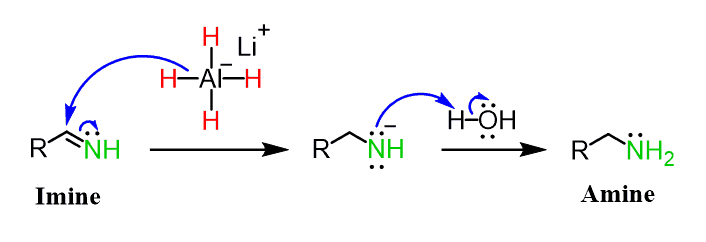
Putting all this together, here is what we get for the amide reduction mechanism:

This does look like too many steps for a reduction reaction, and that’s why the initial deprotonation step is often omitted, emphasizing the reduction part itself:

Even though this may not be an accurate representation of the mechanism, it certainly is acceptable to many instructors. I am totally happy with this mechanism from my students, but double-checking with your instructors is always a good idea.
In the next article, we will discuss the reduction of tertiary amides to amines and aldehydes using common alkylboranes such as 9-BBN and Sia2BH.
Need some good practice on the reactions of carboxylic acids and their derivatives?
Check this 45-question, Multiple-Choice Quiz with a 50-minute Video Solution covering the reactions of acids, esters, lactones, amides, acid chlorides, etc.
Carboxylic Acids and Their Derivatives Quiz
Check Also
- Preparation of Carboxylic Acids
- Naming Carboxylic Acids
- Naming Nitriles
- Naming Esters
- Naming Carboxylic Acid Derivatives – Practice Problems
- The Addition-Elimination Mechanism
- Fischer Esterification
- Ester Hydrolysis by Acid and Base-Catalyzed Hydrolysis
- What is Transesterification?
- Esters Reaction with Amines – The Aminolysis Mechanism
- Ester Reactions Summary and Practice Problems
- Preparation of Acyl (Acid) Chlorides (ROCl)
- Reactions of Acid Chlorides (ROCl) with Nucleophiles
- R2CuLi Organocuprates – Gilman Reagent
- Reaction of Acyl Chlorides with Grignard and Gilman (Organocuprate) Reagents
- Reduction of Acyl Chlorides by LiAlH4, NaBH4, and LiAl(OtBu)3H
- Reduction of Carboxylic Acids and Their Derivatives
- Preparation and Reaction Mechanism of Carboxylic Anhydrides
- Amides – Structure and Reactivity
- Naming Amides
- Amides Hydrolysis: Acid and Base-Catalyzed Mechanism
- Amide Dehydration Mechanism by SOCl2, POCl3, and P2O5
- Amide Reduction Mechanism by LiAlH4
- Amides Preparation and Reactions Summary
- Amides from Carboxylic Acids-DCC and EDC Coupling
- The Mechanism of Nitrile Hydrolysis To Carboxylic Acid
- Nitrile Reduction Mechanism with LiAlH4 and DIBAL to Amine or Aldehyde
- The Mechanism of Grignard and Organolithium Reactions with Nitriles
- The Reactions of Nitriles
- Converting Nitriles to Amides
- Carboxylic Acids to Ketones
- Esters to Ketones
- Carboxylic Acids and Their Derivatives Practice Problems
- Carboxylic Acids and Their Derivatives Quiz
- Reactions Map of Carboxylic Acid Derivatives

